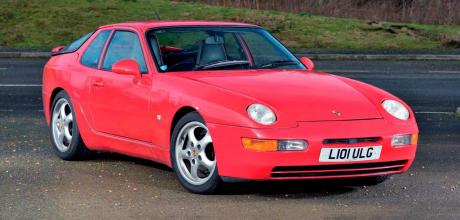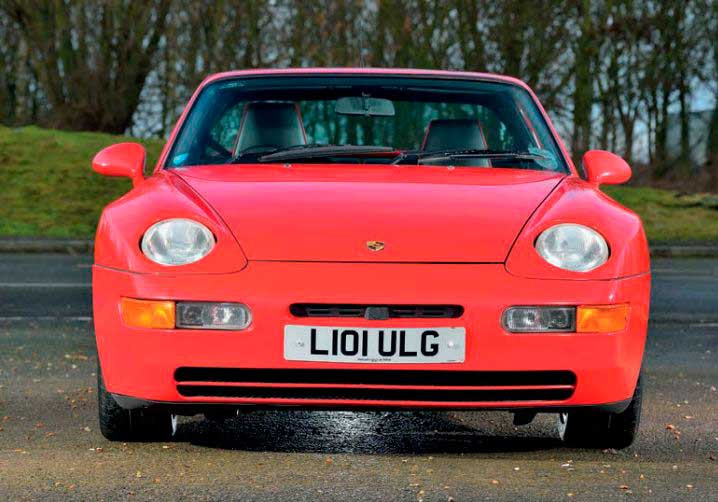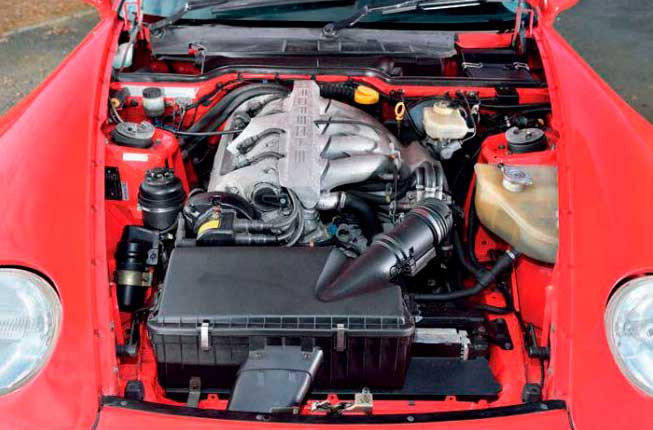Endangered Species: Porsche 968

The last front-engined Porsche until the Cayenne and the brand’s last four-cylinder until the current Boxster, the 968 was the last gasp of a line which had begun with the 924. Words: Richard Gooding. Photography Matt Woods.
THE FINAL FLING
Facts, figures and history on the ultimate evolution of the Porsche 924.
The 944 enjoyed success as blistering as its sills. After the release of the S2 in 1989, factory bosses made plans to develop the model even further. The next-gen 944 was set to wear the S3 designation, but so extensive were the proposed changes, it became clear the resulting car would be more or less an entirely new Porsche. With this in mind, the decision was made to forge ahead with a path that followed the chosen route, but ended with a fresh model. Adopting its development programme codename, the 968 was born.

Launched in August 1991 for the 1992 model year, the new sports coupe from Zuffenhausen comprised a mix of around eighty percent new parts and design elements when compared to its predecessor. Even so, lineage back to the 924 of 1976 was clear to see — the basic profile and window silhouette from the 968’s curvaceous wheel arches upwards was inherited from the first model to be listed in Porsche’s transaxle range of cars. Keen to forge a ‘family resemblance’ between its line of products as the 1990s got underway, however, Stuttgart blessed its new model with 928-esque visible headlamps, complete with pop-up functionality and froglike looks were activated.
The 944’s wide rear quarters remained, though now boasted more integrated bumpers, smoother lines and gently curved edges. Neat touches included carefully considered wing junctions, as well as door handles and mirrors that’ll be familiar to fans of the 993-generation 911 (they debuted on the 968 before the air-cooled car, fact fans!). There was a Fuba ‘bee sting’ aerial, plus subtle Porsche script between all-red rear light lenses. 968 nomenclature sat rear-top-centre, though blink and you’d miss it — Porsche’s new sports machine romped from rest to 62mph in just 6.5 seconds thanks to an upgraded version of the 944’s four-cylinder 16-valve engine. Displacement was now 2990cc, with a power figure of 240bhp in a standard state of tune. New exhaust and induction kit ensured the more powerful engine could breathe easily, while updated engine management electronics and a dual-mass flywheel also enhanced the basic package, delivering super-smooth operation.
Big news concerned the introduction of Porsche’s new VarioCam variable valve timing system. Debuting on the 968, the VVT arrangement would become a feature – some would say a defining one – of the 993. Applied to the 968’s M44/43 powerplant, VarioCam came on song between 1500rpm and 5500rpm, assisting the production of 225lb.ft torque at 4,100rpm. The last four-cylinder Porsche until 2016’s 718-series Boxster, the superb 968 had both the power and the technology to match its streamlined appearance.

A new six-speed gearbox was a ratio up on the outgoing 944’s transmission. Nonpurists who were less than thrilled at the prospect of stirring a stick shift were offered the then three-year-old Tiptronic system as a cost option. Familiar equipment remained, however, in the form of a chassis inherited from the 944 S2, one that could trace its roots back to the introduction of the 944 Turbo; like the boosted 944, the 968 included Brembo four-pot calipers, while extensive use of aluminium suspension components kept kerb weight down to an acceptable 1,370kg.
Production was moved from the 944’s home at Audi’s Neckarsulm plant to Porsche’s Zuffenhausen facility. Echoing the 944 family, both hard-top coupe and convertible versions of the 968 were available to buy, but unlike the 944, the newer transaxle looked less ‘clumsy’ with its roof down, the result of a much sleeker profile and careful consideration of where stowed canvas would reside. To the surprise of the period’s motoring press, performance was undiminished when the new rag-top was pitched against its coupe-bodied sibling. Indeed, those brave enough to have their toupees ruffled could reach 62mph from rest in the same 6.5 seconds as those safely ensconced in a closed-roof 968.
One of the most desirable 968 colours was Speed Yellow. It’s also one of the rarest, particularly in North America, where only ten of the ‘L12G’ brightly-hued 968s are said to reside. Originally a standard no-cost colour, cars in this vibrant shade now attract a premium on the used 968 market.
Club Sports, meanwhile, mostly came in eye-popping shades of Grand Prix White, Guards Red, Maritime Blue, Speed Yellow and Black. During 1994 and 1995, however, most of the standard 968’s colour palette, including the very vibrant Riviera Blue, could be optioned. Club Sport cars specified with M346 trim featured silver wheels, as opposed to colour-coded rims.
The first example of Porsche’s new speed machine hit UK shores in May 1992. The interior of both soft-top and hard-top models was almost ‘identikit’ 944, but no matter – all the essentials were present and correct. Moreover, if anyone dared dismiss Porsche’s new offering as ‘same old, same old’, they were very much mistaken. As if to prove the point, Autocar declared the 968 as “the world’s best-handling car.” Car added its voice to the debate: “there has never been a better-balanced front-engined, rear-drive car than the 944 Turbo, yet the 968 is just as good. Fast, sure-footed and manoeuvrable, it’s thoroughly entertaining on winding roads.” The deal was sealed. Porsche had done what seemed like the impossible – it had developed the 944 (the most successful model in the Stuttgart car maker’s back catalogue up until the arrival of the Boxster) into a model even more admired by the world’s leading automotive journalists. Sales success seemed guaranteed.
While there was little to be found wanting with the standard 968, an appetite for a more focused version of the Stuttgart-badged newcomer resulted in the lightweight 968 Club Sport in 1992. Borrowing its name from more extreme earlier Porsche models, this fresh, track orientated 968 offered a purer driving experience thanks to the dismissal of standard luxury equipment, including heavy sound deadening material. Tipping the scales at 1320kg, the Club Sport was obvious in its intentions. The model’s colour palette was limited to more standout shades, while 17- inch Cup alloys were colour-coded to match the host vehicle’s body panels. Thanks to 20mm lowered suspension, 225-profile tyres tidily filled their enveloping wheelarches. The theme continued inside the car.
Manual cranks replaced electric window mechanisms, lightweight Recaro buckets with manual adjusters and body-coloured backs took the place of power pews, while an airbag-free three-spoke steering wheel added a racier look. The same weight-saving regime saw the 968 coupe’s rear seats binned, as well as the appointment of a small battery and an ‘essentials only’ wiring loom. This hoon-tastic 968 couldn’t be more focused on its enhanced fast-road and track-friendly abilities, qualities it announced to the world in the form of giant model-identifying body graphics. The benchmark 0-62mph dash was achieved in 6.2 seconds. Top speed was registered at 157mph. An M220 option of limited-slip differential made sure all 240 of the Club Sport’s ponies galloped without falter, whatever the ribbon of tarmac they happened to be travelling along.
Just like the standard 968, the Club Sport attracted rave reviews when it was tested by the motoring media. Crowned with a Performance Car of the Year award by Performance Car, the only complaint seemed to be that Porsche’s new offering wasn’t available for all to enjoy: the lightweight Porsche was only available in the UK, Australia, Europe and Japan. The first examples touched down in January 1993, priced at £7000 less than the stock 968 — the cost of joining the Club Sport club was listed as £29,975 in 1994.
Buoyed by the warm welcome received by the gym-fit 968, a 968 Sport model was sold exclusively in the UK from 1994 to 1995. Essentially a Club Sport with selected creature comforts reinstated, the £32,995 Sport was priced £5500 less than a standard 968 and £3000 less than the Club Sport.
Equipment included central locking, cloth Comfort seats, electric windows and the return of rear seats. The Sport’s lean-and- luxury personality proved popular, as demonstrated by the model outselling the standard 968 by almost seven-to-one. Even so, only 306 Sports ever found homes, highlighting just how low 968 production was. Even today, outside of Porsche circles, many don’t even know the model exists!
Sport-focused 968s weren’t the ultimate incarnation of Porsche’s ‘90s transaxle offering. That accolade is reserved for the 968 Turbo S. Limited to just 16 units, the 305bhp quasi-racer looked similar to the Club Sport, but could be correctly identified by its NACA bonnet scoops, brutish front spoiler and adjustable rear wing. The car’s three-litre 944 S2-style engine block featured an eight- valve single overhead-cam cylinder head which encouraged prodigious performance: the 968 Turbo S only needed 4.7 seconds to hit 62mph from a standing start, while top speed was 175mph – 18mph up on the Club Sport. Hefty torque of 370lb.ft ensured power wasn’t far off the beginning-to-be-developed 996-generation 911.
Adding to the Turbo S’s legacy, a quartet of 968 Turbo RSs were built by Porsche’s Motorsport Research and Development division. Essentially a stripped Turbo S, the RS was conceived for Porsche’s customer racing teams and offered in two variants.
First was a 337bhp car built to meet the rules and regulations laid out by the German ADAC GT series. Ballast was added to bring the car up to a minimum weight of 1350kg. Second was a 1212kg ‘international’ spec race car making use of a KKK L41 turbocharger assisting with the development of 350bhp. Each of the four Turbo RSs was painted a different colour (red, yellow, black, white) and are recognised the world over as the rarest 968s ever produced. Perceived demand, however, encouraged Australian-based engineering outfit, Fitzgerald Racing Services, to build four of its own RS-themed 968s using factory-sourced RS parts and Club Sport chassis. Each car was priced at more than AU$225,000 and came customised in accordance with the requirements of each well-heeled buyer.
The 968 proved Porsche’s transaxle line still had a decent amount of life left in it, but all things must pass, and along with discontinuation of the 928 GTS, production stopped in 1995 after 12,776 968s were built (8,402 coupes, 4,374 drop-tops).
This low volume assembly means the 968 is, today, more of an exclusive find than the 944, and like buried treasure, its riches will reward those lucky enough to find their name on a 968’s logbook.
Best of all, used 968 purchase prices have remained sensible (a mint-condition Club Sport will empty your wallet for the same sum as a ropey 911 SC), so get out there and secure a delicious slice of performance Porsche from the marque’s excellent front-engined, water-cooled family of sports cars.
Back in 1992, Porsche experimented with the design of a 968 Roadster, a concept produced to evaluate the enticing prospect of a more glamorous open-top Porsche than any of the company’s other al fresco offerings. A beautiful one-off penned by Porsche styling legend, Harm Lagaay (the same man who had been responsible for developing the 944 into the 968 in the first place), the model featured fixed headlights, a Speedster-inspired lower windscreen rake and a widened rear deck.
Speedline split rims were borrowed from the 964 range, while vivid Tahoe Blue paintwork and a colour-coded dashboard insert were also added to the experimental Porsche.
Despite the Roadster being marked as something special, however, slow 968 sales did little to encourage Lagaay’s superiors of the Roadster’s merit as a full-on production car.
Instead, attention turned to the development of an all-new Porsche. Revealed to the world as the Boxster, its massive success ensured the company’s survival.
The 968’s handling was highly praised by contemporary road testers. Still recognisably of 924/944 descent, the 968 was reckoned to be 80 per cent new. Upgraded Porsche four-cylinder now boasted 3 litres and 240bhp.

